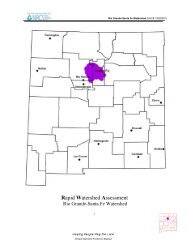SAMPLING VEGETATION ATTRIBUTES - New Mexico NRCS - US ...
SAMPLING VEGETATION ATTRIBUTES - New Mexico NRCS - US ...
SAMPLING VEGETATION ATTRIBUTES - New Mexico NRCS - US ...
You also want an ePaper? Increase the reach of your titles
YUMPU automatically turns print PDFs into web optimized ePapers that Google loves.
14<br />
STUDY DESIGN AND ANALYSIS<br />
d From a sampling perspective, it is the study site that constitutes the target<br />
population. The collection of all possible sampling units that could be placed in<br />
the study site is the target population.<br />
2. Random Sampling Critical to valid monitoring study design is that the sample<br />
be drawn randomly from the population of interest. There are several methods of<br />
random sampling, many of which are discussed briefly below, but the important<br />
point is that all of the statistical analysis techniques available are based on knowing<br />
the probability of selecting a particular sampling unit. If some type of random<br />
selection of sampling units is not incorporated into the study design, the probability<br />
of selection cannot be determined and no statistical inferences can be made<br />
about the population. (Directions for randomly selecting the location of transects<br />
to be run off of a baseline using random number tables are given in Appendix D).<br />
3. Systematic Sampling Systematic sampling is very common in sampling<br />
vegetation. The placement of quadrats along a transect is an example of systematic<br />
sampling. To illustrate, let’s say we decide to place ten 1-square-meter quadrats at<br />
5-meter (or 5-pace) intervals along a 50-meter transect. We randomly select a<br />
number between 0 and 4 to represent the starting point for the first quadrat along<br />
the transect and place the remaining 9 quadrats at 5-meter intervals from this<br />
starting point. Thus, if 10 observations are to be made at 5-meter intervals and the<br />
randomly selected number between 0 and 4 is 2, then the first observation is made<br />
at 2 meters and the remaining observations will be placed at 7, 12, 17, 22, 27, 32,<br />
37, 42, and 47 meters along the transect. The selection of the starting point for<br />
systematic sampling must be random.<br />
Strictly speaking, systematic sampling is analogous to simple random sampling only<br />
when the population being sampled is in random order (for example, see Williams<br />
1978). Many natural populations exhibit an aggregated (also called clumped)<br />
spatial distribution pattern. This means that nearby units tend to be similar to<br />
(correlated with) each other. If, in a systematic sample, the sampling units are<br />
spaced far enough apart to reduce this correlation, the systematic sample will tend<br />
to furnish a better average and smaller standard error than is the case with a<br />
random sample, because with a completely random sample one is more likely to<br />
end up with at least some sampling units close together (see Milne 1959 and the<br />
discussion of sampling an ordered population in Scheaffer et al. 1979).<br />
4. Sampling vs. Nonsampling Errors In any monitoring study, it pays to keep<br />
the error rate as low as possible. Errors can be separated into sampling errors and<br />
nonsampling errors.<br />
a Sampling Errors Sampling errors arise from chance variation; they do not<br />
result from “mistakes” such as misidentifying a species. They occur when the<br />
sample does not reflect the true population. The magnitude of sampling errors<br />
can be measured.<br />
b Nonsampling Errors Nonsampling errors are “mistakes” that cannot be measured.




